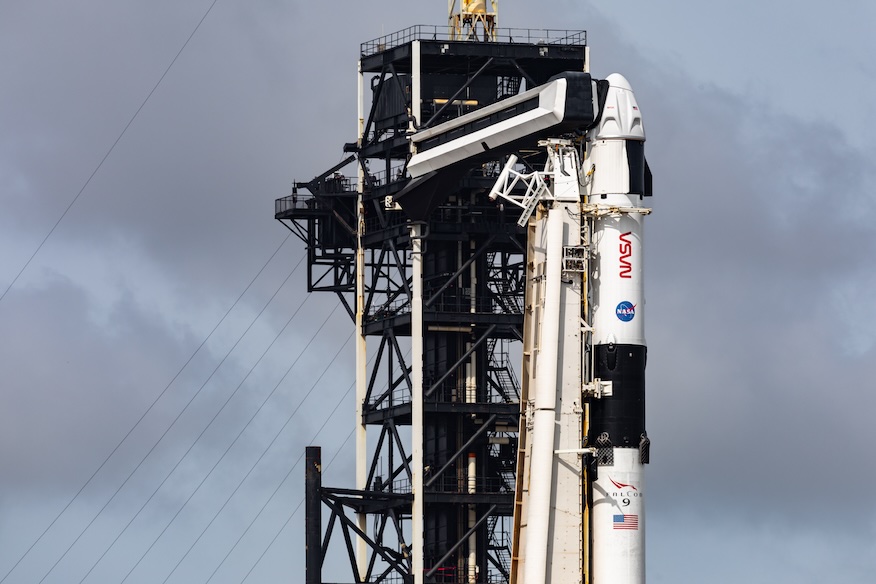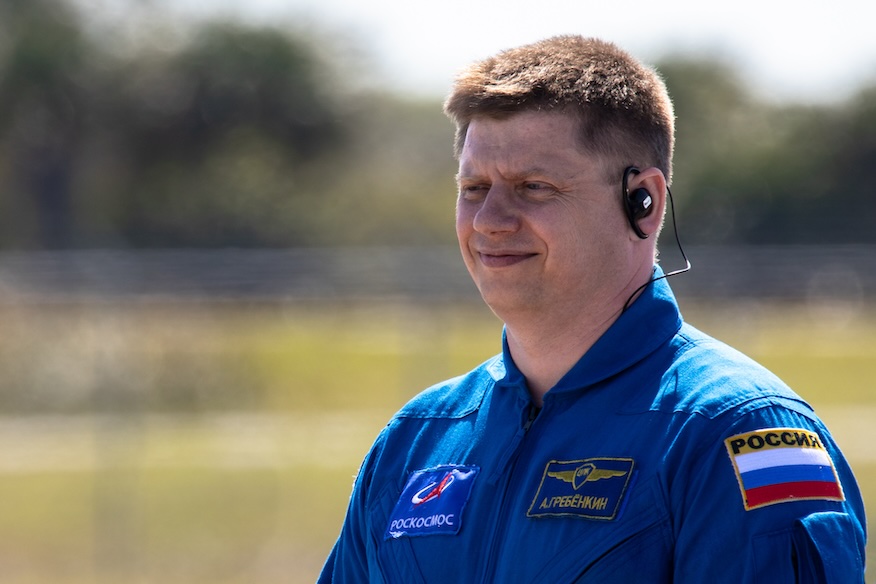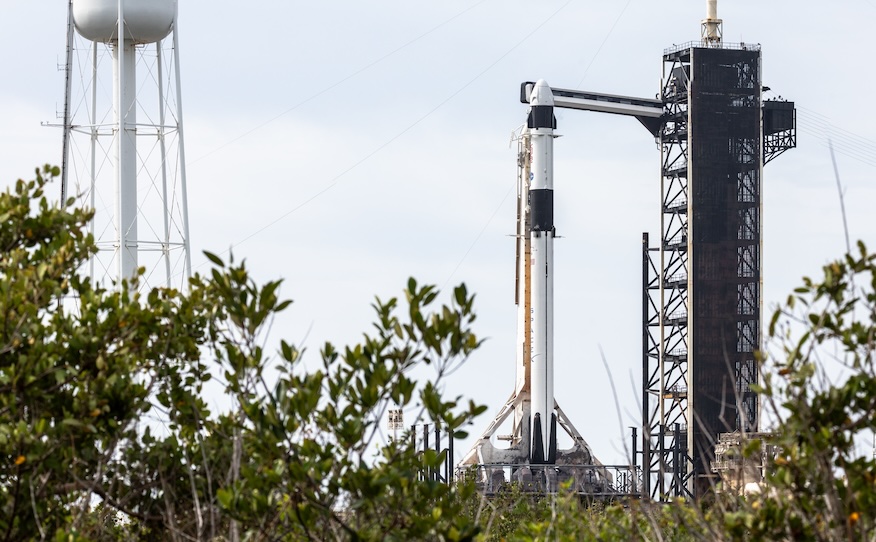
Update 8:00 p.m. EST: NASA and SpaceX are standing down from the launch due to high winds along the ascent corridor.
For the second time this year, SpaceX is preparing to send a quartet of people up to the International Space Station. Its Falcon 9 rocket and Crew Dragon Endeavour spacecraft are standing by at NASA’s Kennedy Space Center. However, they’ll have to wait another day given that weather along the ascent corridor did not permit a launch late Saturday night.
Liftoff of the Crew-8 mission from historic Launch Complex 39A is now set for Sunday, March 3 at 10:53 p.m. EST (0353 UTC Sunday). The launch was also delayed from March 1 due to poor weather in the downrange area off shore where crew would be rescued in the unlikely event of a mid-ascent mission abort.
The 45th Weather Squadron forecast 75 percent chance of favorable weather on Sunday with upper-level wind sheer being a watch item, along with clouds in the area of the launchpad.
Spaceflight Now will have live coverage from the Kennedy Space Center Press Site beginning about four hours prior to liftoff.
[embedded content]
The mission will be a first for three out of the four members of Crew-8. Michael Barratt, the pilot, previously flew a Soyuz and Space Shuttle Discovery to the ISS in 2009 and 2011 respectively.
“The idea of multiple vehicles is just such a positive sign of human spaceflight to begin with,” Barratt said. “Different entities: government agency, private agency, different government agency. Human spaceflight is flourishing and that’s a really good thing.”
Barratt said that while the SpaceX Dragon certainly has its perks as a newer vehicle, there’s something to be admired about his rides from the past.
“There’s a lot of common elements. Physics transfers quite nicely, but the functionality, the redundancy, the safety, the creature comforts, the human interfaces are all different between vehicles,” he said. “And I find that personally very exciting to learn those differences.”
[embedded content]
Mission Specialist Jeannette Epps also trained on three different vehicles. She was first prepared to fly as a member of Expedition 56/57 in 2018, but was pulled from that mission without explanation from NASA. She was then assigned to the first operational flight of Boeing’s Starliner spacecraft before it ran into years of delays.
She said all the commentary by people over the years is not important to her now. Epps said she’s just excited about finally being able to travel to space for the first time after being selected as an astronaut in 2009.
“I gotta stay focused on what’s important and number one for me is trying to be a conscientious worker and in training, being conscientious of the work that’s in front of me and making sure I’m not focusing on things that are not important anymore,” Epps said. “What happened in the past is in the past and it’s going to stay there. I don’t want to bring it forward because we have so much good stuff happening now.”
During a prelaunch press conference, Epps said that she the most important memento she will be taking with her up to space is a picture of her mom. In a one-on-one interview with Spaceflight Now, she emphasized the impact of her mom on her journey.
“She knew that I was selected for the astronaut and her words to me were that ‘I’m so happy for you. This is what you always wanted in life and I know you’re going to do well.’ And then, shortly after that, she passed away, which was kind of intense for me in that moment,” Epps said. “But having the corps and coming to Houston to live really kind of set me on path of really kind of wanting to make my mom proud of me, if that makes sense.”
[embedded content]
Crew-8 Commander Matthew Dominick will be making his first flight to space as well. A member of the 2017 astronaut class, The Turtles, his flight to the space station will help maintain a continuous presence of this group of astronauts. The concept was jokingly called the “Turtle Takeover” by NASA astronaut Raja Chari when he and Kayla Barron launched as members of Crew-3 in 2021.
“We very nearly lost that. Luckily, there was a small accident with a booster that drove into a bridge, cause Crew-5 is great, Crew-5 is a great group of people, but their one drawback was no Turtles,” Dominick quipped. “And so, that moved the Crew-5 launch, it allowed Frank [Rubio] to bridge the gap of continuous turtle presence in space between Crew-4 and Crew-6.”
Dominick came to the astronaut corps from the U.S. Navy where he served as a test pilot. He logged more than 1,600 flight hours onboard 28 aircraft.
“You look at the movies and you think edge of the envelope flying, edge of the envelope of the aircraft, but a lot of test piloting is the planning and the engineering and working with the great groups of people that make it happen. And then every now and then, you go fly a test flight at the edge of the envelope,” Dominick said.
[embedded content]
Rounding out the crew is Roscosmos cosmonaut Alexander Grebenkin. A graduate of Irkutsk High Military Aviation School, he studied engineering and aircraft radio repair. He also studied radio communications and broadcasting at Moscow Technical University of Communications and Informatics.
He began cosmonaut training in 2018 and was awarded the position of test cosmonaut in 2021.
“I would say that for anyone who is doing anything in their life, they need to try and absorb, to the maximum ability, whatever they’re working on and to be and to be as multifaceted as possible,” Grebenkin said, speaking through a translator. “Everything I’ve learned has been very beneficial for me in my career as a cosmonaut. I would say I got selected thanks to what I did before.”
Grebenkin said training on Crew Dragon was challenging. He said the travel time between Russia and the United States for training also made it feel like a lengthy process.
“We had to travel a lot and you’re not just learning the new vehicle, you’re meeting a new training team, you’re getting accustomed to a new training approach. So, this is different,” he said.

New SpaceX records
The launch of the Crew-8 mission will mark the fifth flight of the Crew Dragon Endeavour spacecraft. It is set to become the flight leader of any Dragon spacecraft, either crew or cargo versions.
“We took a little extra time to talk through the work that we had done to make sure that we were ready to go fly that vehicle,” said Steve Stich, NASA’s Commercial Crew Program manager during a prelaunch teleconference. “In particular, we had a number of special topics relative to the prop system.”
Stich said SpaceX replaced a number of valves to address previously seen corrosion on earlier flights. Adding to that Bill Gerstenmaier, SpaceX’s vice president of Build and Flight Reliability, said having had the opportunity to fly 49 people an numerous cargo missions prior to this mission has taught them a lot.
Once Crew-8 launches, SpaceX will have sent a total of 53 people to orbit across 13 Dragon flights.
“We get a chance to experiment and see the hardware on other flights, so there’s a tremendous advantage of flying as often as we do and flying the variety of missions that we get to go fly,” Gerstenmaier said. “It’s really nice to try some things on cargo vehicles and then see how they work and then make sure and then make sure that we’re getting the right performance that we need for the crew missions.”
Currently, Dragon vehicles are certified up to five flights, but NASA and SpaceX are working to extend that out to 15 missions.
“We may not get there in every single system. We’re starting that, we’re in the middle of doing that work. We’re in the middle of going through all those components,” Stich said. “Some are actually approved for 15 flights, some we’re still in the middle of working on, some of those components had to go through some re-qualification to make sure that they can make it out to 15 flights.”
A new Crew Dragon spacecraft is also currently in production in Hawthorne, California. Stich said it would likely be ready to fly the Crew-10 mission in early 2025. Gerstenmaier added that SpaceX anticipates having that vehicle be ready for service by the fall of 2024.
“So whenever NASA wants to go ahead and use that vehicle, it will be available sometime this fourth quarter of this year,” he said.
The first stage booster on this mission, tail number B1083, will be launching for the first time on this mission. It will touch down at Landing Zone 1 (LZ-1) at Cape Canaveral Space Force Station roughly 7.5 minutes after liftoff.
Those in the Central Florida area may hear a sonic boom as the booster comes in for a landing.

- SEO Powered Content & PR Distribution. Get Amplified Today.
- PlatoData.Network Vertical Generative Ai. Empower Yourself. Access Here.
- PlatoAiStream. Web3 Intelligence. Knowledge Amplified. Access Here.
- PlatoESG. Carbon, CleanTech, Energy, Environment, Solar, Waste Management. Access Here.
- PlatoHealth. Biotech and Clinical Trials Intelligence. Access Here.
- Source: https://spaceflightnow.com/2024/03/02/live-coverage-spacex-to-launch-falcon-9-rocket-from-kennedy-space-center-on-astronaut-mission-to-the-international-space-station/



